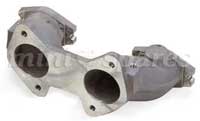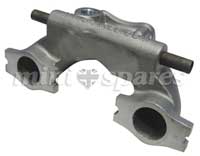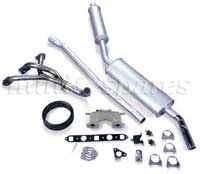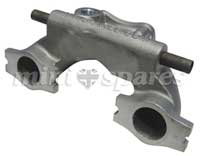
Build the manifold up before fitting to the car. The two spherical ended joints screw into the inlet manifold using the flat washers and nuts to lock them into place. The 5/16” rod is a tight fit into the two joints and care must be taken when fitting. The two linkage brackets fit either end of the 5/16” rod outside of the spherical joints using the 5mm nut and bolt to secure. Fit the small rose joints either end of the threaded rod and fit to the throttle linkage on the side required for the Weber carb being used. The 5” metal bar fits in a vertical position to the manifold, secured on the original manifold studs when fitting to the engine. Read more

These single SU carb manifolds were developed to provide optimum airflow and air speed for the vast majority of road-used cars. The development program saw a significant increase in efficiency following production to the point where they are the best 'off the shelf' manifolds on the market for a majority of applications, including motorsport where only a single SU is allowed, yet not at extreme expense since sand casting methods were employed to keep costs down. Read more

Beware: Instructions must be read carefully.
Although the 998/1300 stage one kits are bolt on parts easily fitted by any person with mechanical knowledge, the following must be understood.
Read more
These single SU carb manifolds were developed to provide optimum airflow and air speed for the vast majority of road-used cars. The development program saw a significant increase in efficiency following production to the point where they are the best 'off the shelf' manifolds on the market for a majority of applications, including motorsport where only a single SU is allowed, yet not at extreme expense since sand casting methods were employed to keep costs down. Read more
Now I just know I'm going to make myself very unpopular with an array of people by doing this article, but I can't help myself. It is something that plagues me continually.
It does not seem to matter which way I try and explain it, or how I represent it, I always meet a barrage of either unsubstantiated or uneducated reason and arguments. So now I have the stage to myself, I will put this as I see it from a wealth of experiment and reasoning over the past twenty years or so.
Exhausts. A subject that a great deal is known about in theory, yet a diminutive amount is actually applied in practice as far as the poor little A series engine is concerned. In fact, the only country where I have seen any money/time put into developing exhaust systems (and that means from cylinder head to the tailpipe) for the venerable little motor, is in America. It is a consequence of those that race and seek the ultimate fully expect to have to pay for it. Read more
The recent rolling road re-test of the 1275 engine build I did saw an opportunity to do some exhaust systems testing.
I had noticed a few years back that the RC40 was being manufactured by a different process than the originals - giving rise to a change in the shape of the bends applied to the system. I had wondered if they would be causing a restriction at all - but hadn't had the opportunity to test it. The lack of expected power from the aforementioned engine lead me to investigate all possible angles from the tyre contact patch to the carb mouth. I found nothing that explained the 14 or so bhp I was 'missing'. After some application of the old grey cells I mentally narrowed cause down to one of two things - either the piston oil control rings were still causing excessive drag (75% of all internal friction of an engine is generated by the piston rings) or perhaps these new bends in the venerable RC40 were indeed causing a power loss.
Read moreStandard cast iron manifolds
Pic 1.
Standard cast iron manifolds - Mini on left, Metro ‘LCB’ type right. One major benefit of cast iron is noise absorption. Tubular steel amplifies resonance caused by exhaust gas phenomena. Stainless steel being THE worst.
Pic 2.
Cooper Freeflow. Careful, exquisite forming of primary pipes and neat welding ensures un-interrupted flow of exhaust gases. Medium length primaries promote performance where mild cams are used.
Pic 3.
Ubiquitous LCB. The two outer ports are connected by short primaries joined to a larger secondary pipe, the centre port getting one pipe all to it’s self. These equally sized pipes continue down under the car, ending in a ‘Y’ piece to join them to the system.
'The third stroke, that following the compression stroke,of our four-stroke Mini engine’s the only one producing power. The other three consume it. Here we’re looking at with exhaust manifolds, so what we need to consider is how to minimise power consumed on the exhaust stroke as the piston pushes the spent gases out.
Recap
Terminology-
LCB -Long centre Branch
A free-flowing set up’s the name of the game - size playing an important role. It’s always assumed a bigger bore pipe will flow better than a small one, so there’s a tendency to follow the ‘biggest is best’ principle and go for the biggest that can feasibly be fitted. Unfortunately it simply doesn’t work, as this generalised and simple view doesn’t consider the phenomena taking place within an exhaust system.
Read moreThe sheer volume and diversity of bolt on goodies available for our cherished Minis underlines the fact that a very large portion of them is modified in some way. Be it just dress up items to personalise it aesthetically, or tuning parts to improve performance.
In the latter’s case, either more power or more economy are sought - both being desired by many. Should it also enhance the looks at the same time, so much the better. Unfortunately not many components can achieve this without integrating with a number of others. The exhaust system, however, is one of the few.
Although the exhaust’s efficiency and effectiveness is reliant on a well matched system from the exhaust valve in the cylinder head to the tail pipe, the majority view it as two separate pieces - the exhaust manifold, and the ‘system’. Not entirely mis-placed, as this is how vendors present them - folk buying one or the other, though mostly both, dependent on guidance and or budget. Read more

